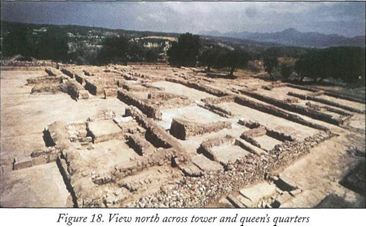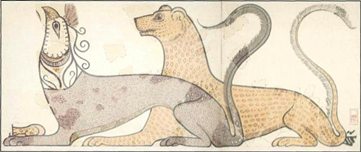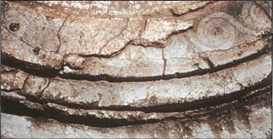Main Buliding
Returning through the lobby and the passage to the main corridor, and going out through a doorway on the left, one enters a small colonnade (44), which had a fa£ade of two wooden columns fronting on the palace court (Fig. 5). They stood on stone bases, and each had a decorative stucco ring around its lower end. The impressions in the stucco show that each column had sixty flutings. The columns must have supported a balcony from which people could look out over the court, with a good view of the ceremonies that no doubt often took place there on state occasions.
At the southeastern end of this stoa are two doorways. The one to the right led to a stairway (54), which still re¬tains three steps and part of a fourth; it ascended to the upper story of a tower-like structure (55-57) beside the pro-pylon (Fig. 18). This may have been the lookout station or the headquarters of the palace guard. The other doorway, on the left, opened into a further corridor (45) from which one could turn left into a rather large and elegant room (46) with a hearth and frescoed wall decoration.

Because it was a smaller version of the throne room (6) in these respects, Blegen dubbed it the queen's hall. It suffered great damage from the fire, no doubt intensified by the olive oil stored on the floor above in the jars that fell into the lobby (38); the oil had spread out into the bath and probably also the adjacent room. The floor of hall 46, which may once have possessed painted decoration, was badly damaged and blackened, and the stones in the walls were calcined. The plaster bearing wall paintings fell in fragments to the floor. Enough has been recovered, however, to show that zoological scenes were favored, with representation of griffins, life-sized lions or lionesses, and other animals, probably on all four walls (Fig. 19).

Figure 19. Griffin and lion fresco from queens hall
The hearth in the center of the room, though much smaller than that in the throne room, was decorated in the same manner, but more delicately, with flame patterns, zigzags, and spirals (Fig. 20). Four or five successive coats of stucco can be counted, each with painted decoration.
A doorway in the northeastern corner of the room led into another walled court (47), similar to the adjacent so-called king's court (42) and like it a late modification to the original building plan, which could not be entered from outside. On the pavement, near the door, were found near¬ly three dozen painted stirrup jars of various sizes.13 Two or three rows of smallish holes aligned across the court might have served for posts to fence off parts of the area. They may have supported an awning to shade part of the enclosure, or a line on which to hang up laundry, or shelving for industrial purposes. The uses to which the court was put cannot be recovered, but the debris found in it suggests that in the final years of the palace's existence it served a humbler purpose than was originally intended for this area.
Another doorway from the queen's hall led into a cor¬ridor (48) from which a branching passage (49) gave access to a small room (50) in the corner of the building.